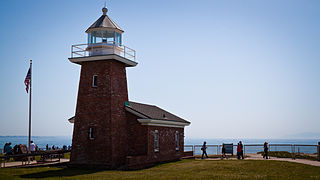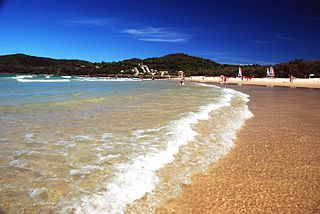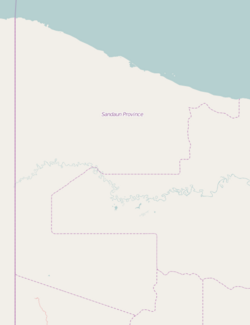
Duke Paoa Kahinu Mokoe Hulikohola Kahanamoku was a Native Hawaiian competition swimmer who popularized the ancient Hawaiian sport of surfing. He was born towards the end of the Kingdom of Hawaii, just before the overthrow, living into statehood as a United States citizen. He was a five-time Olympic medalist in swimming. Duke was also a Scottish Rite Freemason, a Shriner, a law enforcement officer, an actor, a beach volleyball player and a businessman.

Surfing is a surface water sport in which an individual, a surfer, uses a board to ride on the forward section, or face, of a moving wave of water, which usually carries the surfer towards the shore. Waves suitable for surfing are primarily found in the ocean, but can also be found in lakes or rivers in the form of a standing wave or tidal bore.
Boardsports are sports that are played with some sort of board as the primary equipment. These sports take place on a variety of terrain, from paved flat-ground and snow-covered hills to water and air. Most boardsports are considered action sports or extreme sports, and thus often appeal to youth. A large proportion of youth partaking in these sports, together with aesthetic damage to property from sports like skateboarding, has led to many board sports being marginalized by the greater world of sports in the past. However, many board sports are ever-more frequently gaining mainstream recognition, and with this recognition have enjoyed wider broadcast, sponsorship and inclusion in institutional sporting events, including the Olympic Games.

Bodyboarding is a water sport in which the surfer rides a bodyboard on the crest, face, and curl of a wave which is carrying the surfer towards the shore. Bodyboarding is also referred to as Boogieboarding due to the invention of the "Boogie Board" by Tom Morey. The average bodyboard consists of a short, rectangular piece of hydrodynamic foam. Bodyboarders typically use swim fins for additional propulsion and control while riding a breaking wave.

A surfboard is a narrow plank used in surfing. Surfboards are relatively light, but are strong enough to support an individual standing on them while riding an ocean wave. They were invented in ancient Hawaii, where they were known as papa he'e nalu in the Hawaiian language, they were usually made of wood from local trees, such as koa, and were often over 460 cm (15 ft) in length and extremely heavy. Major advances over the years include the addition of one or more fins (skegs) on the bottom rear of the board to improve directional stability, and numerous improvements in materials and shape.

Sky surfing is a type of skydiving and extreme sport in which the skydiver wears a custom skysurf board attached to his or her feet and performs surfing-style aerobatics during freefall.

Skimboarding or skimming is a boardsport in which a skimboard is used to glide across the water's surface to meet an incoming breaking wave, and ride it back to shore. Wave-riding skimboarders perform a variety of surface and air maneuvers, at various stages of their ride, out to, and back with, the wave. Some of these are known as "wraps," "big spins," "360 shove-its" and "180s." Unlike surfing, skimboarding begins on the beach by dropping the board onto the thin wash of previous waves. Skimboarders use their momentum to skim out to breaking waves, which they then catch back into shore in a manner similar to surfing.

San Onofre State Beach is a 3,000-acre (1,214 ha) state park in San Diego County, California. The beach is 3 miles (5 km) south of San Clemente on Interstate 5 at Basilone Road. The state park is leased to the state of California by the United States Marine Corps. Governor Ronald Reagan established San Onofre State Beach in 1971. With over 2.5 million visitors per year, it is one of the five most-visited state parks in California, hosting swimmers, campers, kayakers, birders, fishermen, bicyclists, sunbathers, surfers, and the sacred Native American site of Panhe. It is named after the fourth-century saint Onuphrius.

G-Land, also known as Plengkung Beach, is an internationally renowned surf break situated on the Grajagan Bay, Alas Purwo National Park, East Java, Indonesia about half a day by road from the popular tourist destinations of Bali. G-Land is most commonly reached via boat charter from Bali.

The Santa Cruz Surfing Museum is a museum which was established in May 1986 to document the history of surfing. With collections dating back to the earliest years of surfing on mainland United States, the museum houses a historical account of surfing in Santa Cruz, California.

Wakesurfing is a water sport in which a rider trails behind a boat, riding the boat's wake without being directly pulled by the boat. After getting up on the wake, typically by use of a tow rope, the wakesurfers will drop the rope, and ride the steep face below the wave's peak in a fashion reminiscent of surfing. Wakesurfers generally use special boards, designed specifically for wakes.
The riding of waves has likely existed since humans began swimming in the ocean. In this sense, bodysurfing is the oldest type of wave-catching. Archaeological evidence suggests that ancient cultures of Peru surfed on reed watercraft for fishing and recreation up to five thousand years ago. Standing up on what is now called a surfboard is a relatively recent innovation developed by the Polynesians. The influences for modern surfing can be directly traced to the surfers of pre-contact Hawaii.

Paddleboarding participants are propelled by a swimming motion using their arms while lying or kneeling on a paddleboard or surfboard in the ocean. This article refers to traditional prone or kneeling paddleboarding. A derivative of paddleboarding is stand up paddleboarding also called stand up paddle surfing. Paddleboarding is usually performed in the open ocean, with the participant paddling and surfing unbroken swells to cross between islands or journey from one coastal area to another. Champion paddlers can stroke for hours and a 20-mile (32 km) race is only a warm-up for well-trained paddlers.

The Noosa Festival of Surfing was established in 1992 at Noosa, Queensland by members of the Noosa Malibu Club, as an amateur surfing competition called the Noosa Malibu Classic. It allowed club members to invite friends to surf Noosa's right-hand point breaks and the event's popularity among competitive longboarders gave the club a chance to take the event to a higher level. In 1996 a professional division was introduced and prompted the name change to The Noosa Festival of Surfing (NFoS) in 1998. The World Tandem Surfing Championships were brought to Noosa in 1999 and Stand up paddle surfing was incorporated into the Festival in 2007 with live entertainment and fundraising auctions also being held. In 2008, the festival, sponsored by Global Surf Industries and maintained and managed by USM Events, commenced with the traditional Mixing of the Waters ceremony led by Hawaiian waterman Brian Keaulana. The Noosa Festival of Surfing is an official Association of Surfing Professionals (ASP) Longboard rated event.

Stand up paddleboarding, or SUP, is a water sport born from surfing with modern roots in Hawaii. Stand up paddle boarders stand on boards that are floating on the water, and use a paddle to propel themselves through the water. The sport was documented in a 2013 report that identified it as the outdoor sporting activity with the most first-time participants in the United States that year. Variations include flat water paddling, racing, surfing, whitewater SUP, yoga, and fishing.

Punta del Diablo is a village and seaside locality in Uruguay, Rocha Department, 298 kilometres (185 mi) east from the capital Montevideo. According to the 2011 census, its permanent population consisted of 823 inhabitants, mostly fishermen and artisans, while during high tourism season, the population swells to approximately 25,000, mostly with Argentinians, Brazilians and Europeans on holiday. As with the country it is located in, the primary language spoken in Punta del Diablo is Spanish. In 2008 it was named by the magazine "Lonely Planet" as one of the top 20 places to visit and invest.

A surfboard fin or skeg is a hydrofoil mounted at the tail of a surfboard or similar board to improve directional stability and control through foot-steering. Fins can provide lateral lift opposed to the water and stabilize the board's trajectory, allowing the surfer to control direction by varying their side-to-side weight distribution. The introduction of fins in the 1930s revolutionized surfing and board design. Surfboard fins may be arrayed in different numbers and configurations, and many different shapes, sizes, and materials are and have been made and used.

Bellyboarding is a surface water sport in which the surfer rides a bodyboard on the crest, face, and curl of a wave which is carrying the surfer towards the shore.

Surfing in the United States is a popular hobby in coastal areas, and more recently due to the invention of wave pools, inland regions of the country. It contributes to a lifestyle and culture in which millions participate and which millions more have an interest. USA surfing is the governing body for the sport of surfing in the United States, with surf leagues such as the World Surf League available in the country. Surfing can be traced back to 17th Century Hawaii and has evolved over time into the professional sport it is today, with surfing being included for the first time in the 2020 Summer Olympics in Tokyo.

New Zealand is a popular surfing destination, with a long history of the sport and a varied coastline with locations suitable for all types of surfing. The West coast is notably consistent, with big swells and high winds, whereas the east coast is dominated by cyclone season swells; the North island is notably warmer than the South, but less consistent; mean temperatures range from 7 °C to 20 °C, depending on location and time of year. Winter is more consistent than Summer, with a southeasterly swell. The climate of New Zealand is varied, so different surf conditions are encountered across the islands.


















